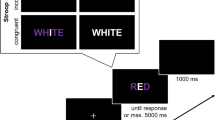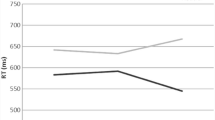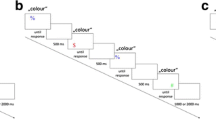Abstract
Responding to the color of a word is slower and less accurate if the word refers to a different color (incongruent condition) than if it refers to the same color (congruent condition). This phenomenon, known as the Stroop effect, is modulated by sequential effects: it is bigger when the current trial is preceded by a congruent condition than by an incongruent one in the previous trial. Whether this phenomenon is due to priming mechanisms or to cognitive control is still debated. To disentangle the contribution of priming with respect to conflict adaptation mechanisms in determining sequential effects, two experiments were designed here with a four-alternative forced choice (4-AFC) Stroop task: in the first one only trials with complete alternations of features were used, while in the second experiment all possible types of repetitions were presented. Both response times (RTs) and errors were evaluated. Conflict adaptation effects on RTs were limited to congruent trials and were exclusively due to priming: they disappeared in the priming-free experiment and, in the second experiment, they occurred in sequences with feature repetitions but not in complete alternation sequences. Error results, instead, support the presence of conflict adaptation effects in incongruent trials. In priming-free sequences (Experiment 1 and complete alternation sequences of Experiment 2) with incongruent previous trials there was no error Stroop effect, while this effect was significant with congruent previous trials. These results indicate that cognitive control may modulate performance above and beyond priming effects.


Similar content being viewed by others
References
Aron, A. R. (2007). The neural basis of inhibition in cognitive control. Neuroscientist, 13(3), 214–228.
Botvinick, M. M., Braver, T. S., Barch, D. M., Carter, C. S., & Cohen, J. D. (2001). Conflict monitoring and cognitive control. Psychological Review, 108(3), 624–652.
Botvinick, M., Nystrom, L. E., Fissell, K., Carter, C. S., & Cohen, J. D. (1999). Conflict monitoring versus selection-for-action in anterior cingulate cortex. Nature, 402(6758), 179–181.
Brown, M., & Besner, D. (2001). On a variant of Stroop’s paradigm: Which cognitions press your buttons? Memory and Cognition, 29, 903–904.
Burns, J. T. (1965). The effect of errors on reaction time in a serial reaction task. PhD dissertation, University of Michigan (unpublished).
De Jong, R., Liang, C. C., & Lauber, E. (1994). Conditional and unconditional automaticity: A dual-process model of effects of spatial stimulus-response correspondence. Journal of Experimental Psychology: Human Perception and Performance, 20, 731–750.
Dutzi, I. B., & Hommel, B. (2009). The microgenesis of action-effect binding. Psychological Research, 73, 425–435.
Dyer, F. N. (1973). The Stroop phenomenon and its use in the study of perceptual, cognitive, and response processes. Memory and Cognition, 1, 106–120.
Floden, D., Vallesi, A., & Stuss, D. T. (2011). Task context and frontal lobe activation in the Stroop task. Journal of Cognitive Neuroscience, 23(4), 867–879.
Gratton, G., Coles, M. G., & Donchin, E. (1992). Optimizing the use of information: strategic control of activation of responses. Journal of Experimental Psychology: General, 121(4), 480–506.
Hommel, B. (1998). Automatic stimulus-response translation in dual-task performance. Journal of Experimental Psychology: Human Perception and Performance, 24(5), 1368–1384.
Hommel, B. (2011). The Simon effect as tool and heuristic. Acta Psychologica, 136, 189–202.
Hommel, B., Proctor, R. W., & Vu, K. P. (2004). A feature-integration account of sequential effects in the Simon task. Psychological Research, 68(1), 1–17.
Ishihara, S. (1962). Tests for Colour-blindness. Tokyo: Kanehara Shuppan.
Kerns, J. G., Cohen, J. D., MacDonald, A. W., Cho, R. Y., Stenger, V. A., & Carter, C. S. (2004). Anterior cingulate conflict monitoring and adjustments in control. Science, 303(5660), 1023–1026.
Kornblum, S., Hasbroucq, T., & Osman, A. (1990). Dimensional overlap: cognitive basis for stimulus-response compatibility—a model and taxonomy. Psychological Review, 97(2), 253–270.
Mansouri, F. A., Buckley, M. J., & Tanaka, K. (2007). Mnemonic function of the dorsolateral prefrontal cortex in conflict-induced behavioral adjustment. Science, 318(5852), 987–990.
Mayr, U., Awh, E., & Laurey, P. (2003). Conflict adaptation effects in the absence of executive control. Nature Neuroscience, 6(5), 450–452.
McLeod, C. M. (1991). Half a century of research on the Stroop effect: An integrative review. Psychological Bulletin, 109, 163–203.
Nieuwenhuis, S., Stins, J. F., Posthuma, D., Polderman, T. J. C., Boomsma, D. I., & de Geus, E. J. (2006). Accounting for sequential trial effects in the flanker task: Conflict adaptation or associative priming? Memory & Cognition, 34(6), 1260–1272.
Notebaert, W., Gevers, W., Verbruggen, F., & Liefooghe, B. (2006). Top-down and bottom-up sequential modulations of congruency effects. Psychonomic Bulletin & Review, 13(1), 112–117.
Notebaert, W., & Soetens, E. (2003). The influence of irrelevant stimulus changes on stimulus and response repetition effects. Acta Psychology (Amst), 112(2), 143–156.
Notebaert, W., Soetens, E., & Melis, A. (2001). Sequential analysis of a Simon task—evidence for an attention-shift account. Psychological Research, 65(3), 170–184.
Notebaert, W., & Verguts, T. (2007). Dissociating conflict adaptation from feature integration: a multiple regression approach. Journal of Experimental Psychology: Human Perception and Performance, 33(5), 1256–1260.
Oldfield, R. C. (1971). The assessment and analysis of handedness: The Edinburgh inventory. Neuropsychologia, 9(1), 97–113.
Pardo, J. V., Pardo, P. J., Janer, K. W., & Raichle, M. E. (1990). The anterior cingulate cortex mediates processing selection in the Stroop attentional conflict paradigm. Proceedings of the National Academy of Sciences of the United States of America, 87(1), 256–259.
Posner, M. I., & Snyder, C. R. R. (1975). Attention and cognitive control. In R. L. Solso (Ed.), Information Processing and Cognition: The Loyola Symposium (pp. 55–85). Hillsdale, NJ: Erlbaum.
Stroop, J. R. (1935). Studies of interference in serial verbal reactions. Journal of Experimental Psychology, 18, 643–662.
Sturmer, B., Leuthold, H., Soetens, E., Schroter, H., & Sommer, W. (2002). Control over location-based response activation in the Simon task: behavioral and electrophysiological evidence. Journal of Experimental Psychology: Human Perception and Performance, 28(6), 1345–1363.
Tipper, S. P., & Cranston, M. (1985). Selective attention and priming: Inhibitory and facilitatory effects of ignored primes. Quarterly Journal of Experimental Psychology A, 37(4), 591–611.
Vallesi, A., & Umiltà, C. A. (2009). Decay of stimulus spatial code in horizontal and vertical Simon tasks. Journal of General Psychology, 136(4), 1–24.
West, R., & Moore, K. (2005). Adjustments of cognitive control in younger and older adults. Cortex, 41(4), 570–581.
Wühr, P., & Ansorge, U. (2005). Exploring trial-by-trial modulations of the Simon effect. Quarterly Journal of Experimental Psychology A, 58(4), 705–731.
Acknowledgments
This study was partially supported by an ESCoP Early Career Stimulus award to OP. The authors thank Bernhard Hommel and Peter Wühr for their useful comments on a previous version of this manuscript.
Author information
Authors and Affiliations
Corresponding author
Rights and permissions
About this article
Cite this article
Puccioni, O., Vallesi, A. Sequential congruency effects: disentangling priming and conflict adaptation. Psychological Research 76, 591–600 (2012). https://doi.org/10.1007/s00426-011-0360-5
Received:
Accepted:
Published:
Issue Date:
DOI: https://doi.org/10.1007/s00426-011-0360-5




